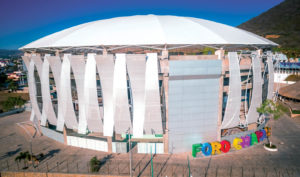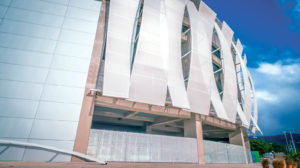An iconic new performance space in southern Mexico demonstrates the ability of tensile fabrics to make a cultural statement—and thrill an audience.

The power of suggestion is one of an architect’s most eloquent tools. With a meaningful combination of shape and material, a design can meet physical expectations as well as create the suggestion of ideas, symbols and traditions. With the strategic use of high-tensile fabric panels, the structure known as the Fachada Foro Chiapas suggests time, place and space beyond its thin walls.
When the Guadalajara firm Lonas Lorenzo was asked by the Mexican government to design a facade for a new arena for rodeo events, known as charreria, two competing objectives directed the project. First, it needed to be a modern, iconic design befitting an international cultural destination. In addition to the rodeo, the facility would host festivals, concerts and other large events in the urban heart of Tuxtla Gutiérrez, Chiapas. Even while covering the structure, however, the facade needed to suggest the deeply rooted tradition of open-air games. Since the 16th century, when haciendas first hosted competitions to display the skills and daring of the local ranchers who worked with their cattle and horses, charreria have been an important cultural event.
Design and function
Lonas Lorenzo architect Cesar Eloy Perez Mercado thought the right tensile fabric could accomplish both goals. Expressive yet extremely durable, a high-tension mesh material could offer structural definition and also suggest openness to the sky through transparency created by the open weave and strategic placement of panels. The firm selected a Serge Ferrari microclimatic facade material called Soltis FT 381. The Fachada Foro Chiapas, which opened in 2016, offers event-goers a memorable experience in which they are protected from the elements in a stunning modern structure that also feels like it’s just within reach of the stars.
The Fachada Foro Chiapas earned the IFAI 2017 Outstanding Achievement Award in the facades category.
“We had worked with the Soltis material before, and we liked how it looked; we liked how it was to work

with, and the way it handles light from both the inside and the outside is very nice,” says Mercado. “It is super lightweight, around only 600 grams per square meter, which makes the entire structure feel very airy. It also has superior thermal qualities.”
The Foro Chiapas is a circular building with a solid perimeter base with concrete columns reaching up to an umbrella-like tensile roof, which is covered with a nonpermeable Serge Ferrari fabric called Flexlite (formerly Précontraint®) 1202. In keeping with tradition, seating is arranged around a central performance area. What gives the structure its distinctive shape and profile, however, is a series of 36 alternating fabric arches that curve inwards and outwards around the structure’s exterior, concealing the columns. Between the panels, passersby might catch tantalizing glimpses of light and activity within the building, but they’ll have to buy a ticket if they want to see the show.
“When you are on the outside of the building looking up at it during the day, the Soltis fabric is so solid that it seems like you’re looking at aluminum,” says Steve Fredrickson, sales manager with Serge Ferrari North America. “At night, the building really comes alive, because you can see through it. It becomes transparent. The fabric weave is 18 percent open, so it does offer high visibility, but the nature of that visibility changes depending on the light conditions and time of day. At night when you are inside the building, you feel like you have contact with the stars and clouds. It seems so open, but you’re in a protected space.”
According to Mercado, the building is used at all times of day, but the charreria events traditionally take place during the afternoon in the bright midday sun.
More than a facade
The Soltis fabric has been in use for 15 years, and its earliest examples are still performing well, says Fredrickson. Made from bundled strands of high-tenacity polyester, it’s extremely resistant to fading and wear. Its “weave-first, coat-second” production process yields a final product that is effectively a perforated composite membrane. Lightweight and easy for installers to manipulate and stretch, it’s also a long-term structural solution.
In the high-heat climate of southern Mexico, the material allows for air movement while also shielding the interior from the full force of the sun. It is so effective at shielding against UV rays that significant energy savings can be achieved with even modest awnings. (The Sotheby’s International Realty building in Rolling Hills Estates, Calif., was outfitted with an earlier version of the product, Soltis FT 371, in 2005. The building’s owners report that after a facade of panels wrapped in Soltis was applied, they saw a $60,000 reduction in energy costs per year—and the aesthetics of the building were greatly improved.) The material effectively creates a microclimate, or as Serge Ferrari terms it, a bioclimatic facade. UV isn’t the only climate force it can defend against. Frederickson says that Hurricanes Irma and Harvey demonstrated the material’s power to withstand climate extremes, like gale-force winds.
“We were concerned about how the Soltis would withstand the weather conditions we saw in the fourth quarter of 2017, but there was no damage whatsoever,” he said. “The fabric is installed in Miami, Houston and Los Angeles, which all see serious weather conditions, yet we found that it performed as designed. When a load is applied to Soltis panels, they stay in position.”
If the fabric does become damaged, it is also 100 percent recyclable. Serge Ferrari has also recycled tons of scraps left over from the production process, making it a highly sustainable choice.
According to Frederickson, the fabric is in use throughout the world, including on 40 different facades across North America. Projects include an FBI parking ramp, an airport in Norway, the Penang International Sports Arena, Copenhagen Concert Hall and numerous hospitals, office buildings, schools and municipal buildings.
When Lonas Lorenzo accepted the Foro Chiapas job, the firm had a tight deadline—very tight. “We began the design just one month before the building opened. We were able to design the facade, get the materials, construct the panels and install them all within that time frame,” says Mercado, who directed the installation of two arch panels a day for 18 days. It went off without a hitch. “We knew we could count on the material and we were very confident in our design. When we do things like this, clients come back to us again. We like to say we make the impossible possible.”
Amy Goetzman is a freelance writer based in St. Paul, Minn.
 TEXTILES.ORG
TEXTILES.ORG


